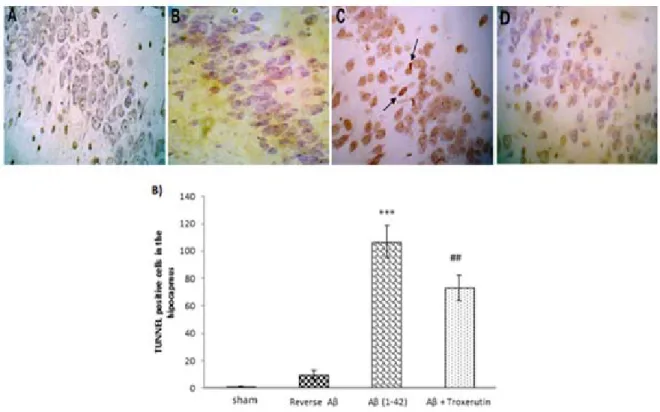Original article:
TROXERUTIN PROTECTS HIPPOCAMPAL NEURONS AGAINST AMYLOID BETA-INDUCED OXIDATIVE STRESS AND APOPTOSIS Fereshteh Farajdokht1, Mohammad Amani
2, Fariba Mirzaei Bavil
2, Alireza Alihemmati
2, Gisou Mohaddes
2, Shirin Babri
1*
1
Neurosciences Research Center (NSRC), Tabriz University of Medical Sciences, Tabriz, Iran
2
Drug Applied Research Center of Tabriz University of Medical Sciences, Tabriz, Iran
* Corresponding author: Dr. Shirin Babri, Neurosciences Research Center (NSRC), Tabriz University of Medical Sciences, Tabriz, Iran.
Tel./Fax number: +98-41-33364664; E-mail: shirinb46@yahoo.com
http://dx.doi.org/10.17179/excli2017-526
This is an Open Access article distributed under the terms of the Creative Commons Attribution License
(http://creativecommons.org/licenses/by/4.0/).
ABSTRACT
Alzheimer’s disease (AD) is an age-related neurodegenerative disease linked with increased production and/or deposition of amyloid-beta (Aβ) in the brain. The aim of the present study was to investigate the possible neuro- protective effect of troxerutin on an animal model of Alzheimer's disease. Alzheimer model was induced by a single dose intracerebroventricular (ICV) injection of Aβ 1–42 (5 nmol/5 µl). Thereafter, troxerutin (300 mg/kg) was gavaged for 14 days. The hippocampal malondialdehyde (MDA) levels and enzymatic activities of superoxide dismutase (SOD), glutathione peroxidase (GPx), and acetylcholinesterase (AChE) were measured using enzyme- linked immunosorbent assay (ELISA) method. In addition, the number of apoptotic cells in the dentate gyrus (DG) was assessed by TUNEL kit. The results showed that ICV microinjection of Aβ 1-42 increased MDA levels, re- duced SOD and GPx, and increased AChE activities in the hippocampus. Chronic administration of troxerutin significantly attenuated MDA levels and AChE activity and increased SOD and GPx activities in the hippocampus.
Moreover, the number of apoptotic cells was decreased by troxerutin treatment. Taken together, our study demon- strated that troxerutin could increase the resistance of hippocampal neurons against apoptosis, at least in part, by diminishing the activity of AChE and oxidative stress. Therefore, troxerutin may have beneficial effects in the management of Alzheimer's disease.
Keywords: Alzheimer’s disease, amyloid beta, acetylcholinesterase, oxidative stress
INTRODUCTION
Alzheimer’s disease (AD) is a neuro- degenerative disease characterized by pro- gressive loss of memory and cognitive func- tion (Butterfield and Boyd-Kimball, 2004).
AD is the most common cause of dementia in the people over 65 years which imposes a sig- nificant economic burden on families and so- ciety, and remarkably decreases the quality of life (Takizawa et al., 2015).
Two main neurological hallmarks in AD are extracellular senile plaques and intracellu- lar neurofibrillary tangles in the brain regions critical for learning and memory, the hippo- campus and other cortices, resulting in the loss of neurons and synapses (Blennow and Hampel, 2003; Giannakopoulos et al., 2003;
Hardy and Selkoe, 2002). Although, the exact
mechanism of AD remains unclear, it seems
that alterations in the production and pro-
cessing of Aβ leads to accumulation of Aβ

